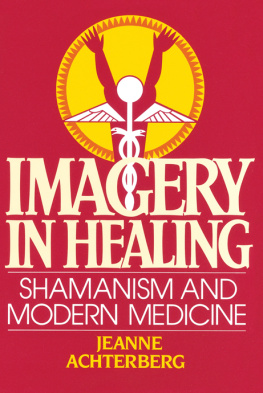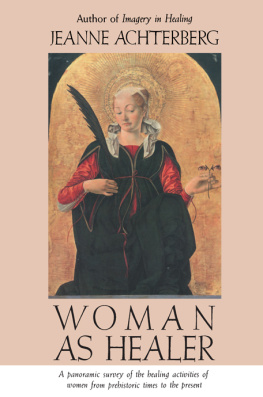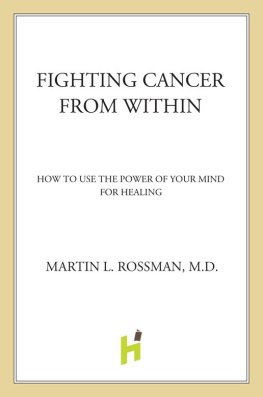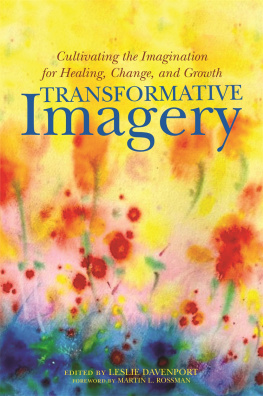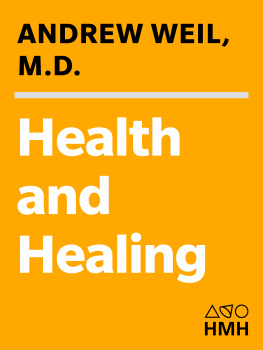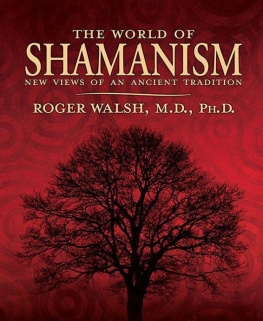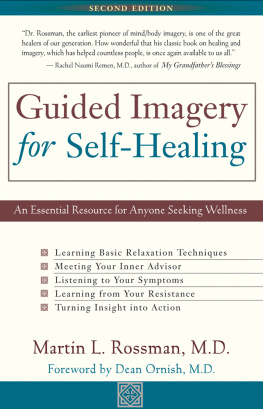A real landmark in holistic medical studies. For those of usand there are more of us all the timewho think it is time to take responsibility for ourselves and our well-being, this is exciting stuff.
Frena Bloomfield, San Francisco Chronicle Review
I would encourage both laypersons and professionals to read Imagery in Healing to understand how one's belief can physiologically affect the human body.
Charles P. Ledergerber, M.D., Journal of theAmerican Medical Association
ABOUT THE BOOK
This influential book shows how the systematic use of mental imagery can have a positive influence on the course of disease and can help patients to cope with pain. In Imagery in Healing, Jeanne Achterberg brings together modern scientific research and the practices of the earliest healers to support her claim that imagery is the world's oldest and most powerful healing resource. The book has become a classic in the field of alternative medicine and continues to be read by new generations of health care professionals and lay people.
In Imagery in Healing, Achterberg explores in detail the role of the imagination in the healing process. She begins with an exploration of the tradition of shamanism, the medicine of the imagination, surveying this time-honored way of touching the nexus of the mind, body, and soul. She then traces the history of the use of imagery within Western medicine, including a look at contemporary examples of how health care professionals have drawn on the power of the imagination through such methods as hypnosis, biofeedback, and the placebo effect.
Ultimately, Achterberg looks to the science of immunology to uncover the most effective ground for visualization, and she presents data demonstrating how imagery can have a direct and profound impact on the workings of the immune system. Drawing on art, science, history, anthropology, and medicine, Imagery in Healing offers a highly readable overview of the profound and complex relationship between the imagination and the body.
JEANNE ACHTERBERG, Ph.D., is a professor of psychology at the Institute of Transpersonal Psychology, and has served as associate professor and director of research in rehabilitation science at Southwestern Medical School in Dallas.
Sign up to learn more about our books and receive special offers from Shambhala Publications.

Or visit us online to sign up at shambhala.com/eshambhala.
Imagery in Healing: Shamanism and Modern Medicine
Jeanne Achterberg

Shambhala
Boston & London
2013
Shambhala Publications, Inc.
Horticultural Hall
300 Massachusetts Avenue
Boston, Massachusetts 02115
www.shambhala.com
1985 by Jeanne Achterberg
Cover design by David Gatti
All rights reserved. No part of this book may be reproduced in any form or by any means, electronic or mechanical, including photocopying, recording, or by any information storage and retrieval system, without permission in writing from the publisher.
Library of Congress Cataloging in Publication Data
Achterberg, Jeanne, 1942
Bibliography: p.
Includes index.
1. Medicine and psychology. 2. Mind and body. 3. Imagery (Psychology) 4. Medicine, Psychosomatic.
I. Title.
R726.5.A24 1985 615.5 84-20748
eISBN 978-0-8348-2629-8
ISBN 0-87773-307-4
ISBN 0-394-73031-3 (Random House)
ISBN 1-57062-934-X (pbk.)
Contents
This book belongs to Frank Lawlis, my husband, who sired it in every sense. It was a matter of circumstance that I became the scribe for the adventure. The journeys through the shamans world, the teasing out of scientific principles to support the data wed gathered, the clinical replications of material that ranged far afield from contemporary psychology and medicineall are part of our close personal and professional relationship. He is first and foremost a scientist, as am I. The shamans role was mutually donned in pursuit of the depths of scientific discovery. And, in as much as I respect his fine skills as a statistician and his sensitive judgments as a clinician, I am likewise able to feel confident in my own similar observations. We give each other courage and support to move out into the unsanctioned regions of consciousness, and confidence that the direction is good.
I would very much like to thank those people who made space in their lives over the past several years, so that I could have the luxury of researching and writing. I will always have fond memories of writing fervently to meet the deadlines, looking up periodically to see the seasons change in our beautiful woods. The time has truly been a gift.
My children should be thanked for their special contributions: Barry, who kept me in tune with the present and tolerated my absent-mindedness in the tasks of daily living, and Lee Ann, who took on the tedious, unrewarding task of working on the books bibliography. Also, the manuscript review work and general emotional support of Barbara Peavey and Maggie Marrero were greatly appreciated.
My gratitude is expressed to the faculty and resources of the Department of Rehabilitation Science. In many ways, the department remains a stronghold of classicbut, unfortunately, rareacademic freedom. In dealing with people who are often regarded as hopeless cases, with people whose lives are completely altered by their physical disability, no direction of thought that might improve the human condition is considered an improper inquiry. The students have been especially helpful in their willingness to listen, offer comments, and read sections of the manuscript. Nan Wells and David Casey are to be commended for their extended efforts.
Three people deserve mention as major influences, not only on my work, but I believe also on the direction of the cultural evolution. First, I learned from Huston Smith, philosopher and master teacher, how necessary it is to look beyond the petty differences of doctrine for the threads of truth and validity in the spiritual viewpoint, and, indeed, how we as scientists cannot escape the relevancy of that viewpoint in plying our trade. Second, in countless instances over the past decade, Ive taken a jog in my personal path, or a new turn in my research, and looked backward in time only to see Larry LeShan already there, glasses hung about his neck, chuckling, swinging his machete mind to blaze the trail. And finally, Michael Hamer entered our lives most recently and has helped pull many of the pieces together with his wonderful, experiential, academic approach to ancient ways. And from all of them, Ive learned maybe the most important lesson of all: the need to be able to find humor in the Divine Order.
A very special acknowledgment is due to Virginia Hine, dear friend and mentor, whose gently felt presence continues its great influence on my thoughts. The concept for the book arose out of night-long discussions and scores of letters, which had nothing overtly to do with science or shamans or medicine, or so we thought. Rather, they had to do with relationships between people who sensed a special love for each other, as Frank and I did, and as she and her husband had. We called it a holobond, and a network of likeminded souls formed, with Virginiaever the cultural anthropologistat the helm. The painful, ecstatic unfolding and enfolding of oneself into the other person and back, the recognition of having been cut from the same fabric and knowing full well an eternal inseparability led all of us to reexamine our personal views of reality. Hints of the texture of this enormous perplexity came to us through myths and legends, the great spiritual teachings, and new developments in science. The material herein was found as a vital part of that exploration.
Next page
